
Kampala, Uganda | THE INDEPENDENT | On Saturday, November 24, 2018, MV Templar started a journey that would take it to K-Palm Beach in Mpatta Sub County, Mukono district. A bash had been organized the other side of the lake and was supposed to be attended by an assemblage of Kampala’s celebrities, tycoons and party hoppers.
But the party never was. The boat, which was suspected to have more than 100 people on board, capsized, sending a wave of panic across the country. More than 30 lives were lost in a whisker. According to UPDF divers, the vessel sunk in an area about 4.9 meters deep. However, many could not swim, to the shoreline, which was about 150 meters away.
But what could have gone wrong? Uganda Radio Network went on an expedition to retrace the journey that left families and friends quaking.
The vessel was expected to set off from KK beach in Gaba at 2 p.m. for a ride to K-Palm Beach, located about 17 nautical miles away from Gaba Landing Site. This is a 15 minutes’ cruise on a speed boat and about three hours on a slow moving boat cruise.
However, the journey did not start on time and revelers had to wait for more than three hours for the boat to arrive. While waiting, they were feasting on drinks and snacks which were supplied at no cost by the organisers of the party. Some invited colleagues from Kampala to join the fun, in what they expected to be a fun filled ride from the beach to the other side of the Lake.
A welder only identified as Umar at Ggaba beach says he was called to help fix the MV Templar boat that same afternoon. Information received from K-Palm Beach in Mukono district indicates that the vessel had been grounded for weeks while undergoing repair. On that day, it was pushed from the land at K-Palm by a tractor which is believed to have punctured it in the process.
It was this puncture on its keel that Umar was called to repair to stop water from entering the vessel before revelers could board.
Unlike other marine vessels, MV Templar couldn’t dock at the nearby pier at Gaba even with the welding that was hurriedly done, something that raised suspicion among the revelers. At around 4:30 p.m. canoes started ferrying revelers to the MV Templar which was stationed about 120 meters away.
From the start of the journey, the passengers were in a partying mood, drinking, dancing and shouting in competition with the loud music on the vessel.
While the State Minister for transport Aggrey Bagiire says marine police tried to block people from boarding the vessel, the revelers reportedly used their influence to board. Amos Kasekende, a fisherman at Gaba landing site says Marine Police officers were near the vessel but none of them intercepted it.
The vessel later set off, albeit, without a licensed captain. It was manned by a Quarter Master with the help of the boat owner Micheal Bisasse also known as Templar. URN has learnt that a fortnight before, David Ssenyonjo, a marine operator was invited by the boat owner to work on the vessel but declined the offer. He later said that he was discouraged by the state of the vessel.
Jackson Mutyaba, one of the coxswains at Gaba Landing Site says that barely 500 meters after they had set off, he saw marine police officers at the National Water And Sewerage Corporation site intercepting MV Templar. Mutyaba was in a different boat traveling to Entebbe.
This information is corroborated with the Police Director for Operations Asuman Mugyenyi who confirmed that there was police intervention at the time. However, Mugenyi says that the information still needs to be verified to establish why it was intercepted and why it was let go thereafter.
After the police move, the party continued. The vessel proceeded enroute K-Palm Beach. It was however intercepted by a local canoe transporting sand from an annex Bulingule Island cautioning them that he had detected danger. But occupants of Templar’s boat rubbished him saying they did not want to buy sand.
Jackson Mutyaba says that one of the occupants of the boat with sand returned to the landing site and told them that he had sensed danger with MV Templar and that people needed to be helped out of the boat before a catastrophe befell them.
Moments later, a fisherman at Gaba Landing Site received a call from the MV Templar crew alerting him that the boat was submerged in water and was unlikely to make it to its final destination. This seems to be the only form of communication available for MV Templar.
This is in contravention of guidelines that require all marine vessels carrying passengers to have automated communication systems connected with all marine vessels on the lake. Vessels are also expected to have radars, eco sounders and navigation chats to establish where and how deep they are at a given time and where they are going. The system also enables the captain to know where it can easily secure the emergency landing.
Novat Baliremwa Mukajanga, a Marine Officer attached to the Ministry of Works says that under normal circumstances, the vessel would have ballistic tanks that help improve its buoyance. Unfortunately, MV Templar had none of the said requirements. The captain was only operating the vessel with traditional knowledge of traversing the lake.
Eyewitness accounts show that the Quarter Master of the vessel at this point decided to divert the boat to a nearby shoreline. However, as they approached an area known as Kisiisi, the vessel was again diverted since the shoreline was rocky and not suitable for landing. It was at this point that a decision was made to sail towards the nearby Mutima Country Haven which had a more suitable shoreline.
32-year-old Shamila Nsereko, a survivor of the tragedy, says that the vessel started losing balance as it turned towards Mutima beach. The crew repeatedly advised the people on board to Balance the Boat. However, the advice was ignored until the revelers realized that the boat had been flooded. It then sunk in; the boat was sinking.
But the people ashore took long to realize that the people on MV Templar needed to be rescued. All they heard was the loud music on the boat. Fred Rwigyema, one of the first responders says they only sensed danger when the speaker went off. They had been deliberately thrown out to decongest the boat.
This is the same moment that those on the vessel noticed that all was not well. They immediately started screaming for help leading to a stampede. For some of them it was too late, for others, the rescue mission was just starting.
“We sailed to their rescue in canoes. They were so many and couldn’t be loaded in one boat. Some of them swam. We rescued some.” Rwigyema says although he could not point out the exact number of those rescued. He adds that the rescue mission aborted when the revelers failed to control their emotions, overrunning rescue boats.
One such occurrence led to the death of one, Bosco Owecho, a fisherman who was swarmed by desperate revelers, looking at his boat as their only chance for survival. Instead, the boat sunk, along with everyone on board.
 The Independent Uganda: You get the Truth we Pay the Price
The Independent Uganda: You get the Truth we Pay the Price





